Trees Birds Mammals Fish Amphibians Reptiles
Wild Algarve
Bookshop
Trametes hirsuta (Wulfen) Lloyd - Hairy Bracket
Phylum: Basidiomycota - Class: Agaricomycetes - Order: Polyporales - Family: Polyporaceae
Distribution - Taxonomic History - Etymology - Identification - Culinary Notes - Reference Sources
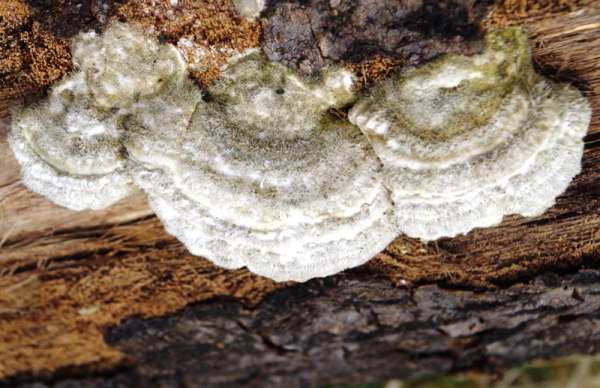
When very young, Hairy Bracket Trametes hirsuta is easily confused with Downy Bracket Trametes pubescens, but as it matures the Hairy Bracket develops tell-tale concentric ridged colour zones (see below) which clearly distinguish it from its more finely downy relative.
The young fruitbodies in the picture below and at the foot of this page were found growing on the trunk of a diseased apple tree in the Dordogne region of France
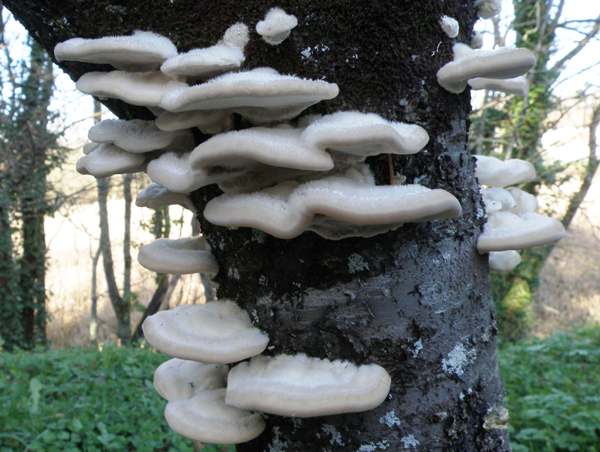
Distribution
Fairly common and widespread in Britain and Ireland, this polypore is also plentiful in northern and central mainland Europe and is also a frequent find in many parts of the world including China and North America. The pictures above and in the identification table are from Norway and are shown by courtesy of Arnor Gullanger.
Taxonomic history
The Hairy Bracket fungus was described scientifically in 1789 by the Austrian mycologist Franz Xavier von Wulfen (1728 - 1805), who gave it the binomial name Polyporus hirsutus. In 1924 American mycologist Curtis Gates Lloyd (1859 - 1928) transferred this species to the genus Trametes, establishing its currently-accepted scientific name Trametes hirsuta.
Synonyms of Trametes hirsuta include Daedalea polyzona, Boletus hirsutus Wulfen, Polyporus hirsutus (Wulfen) Fr., Coriolus hirsutus (Wulfen) Quél., and Polystictus hirsutus (Wulfen) Cooke.
Etymology
Trametes, the genus name, comes from the prefix tram- meaning thin and -etes meaning 'one whi is' - hence the implication is that fruitbodies of fungi in this genus are thin in section.
The specific epithet hirsuta is derived from the Latin adjective hirsutus, meaning coarsely hairy, and is a reference to the hairy upper surfaces of young brackets of this species.
Identification guide
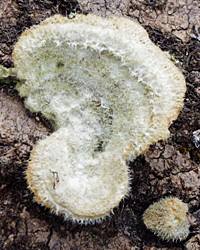 |
Upper (infertile) surface
Brackets are usually semicircular and 4-10cm in diameter when fully grown. Initially white or cream with the upper surface covered in silvery hairs, the brackets tend to develop an ochre or brownish region near the margin and are concentrically zoned with narrow yellow-ochre or brown regions and are visibly ridged (see main picture) at maturity.
Adjacent caps sometimes merge and fuse together, and the fruitbodies gradually turn greyer before decaying. |
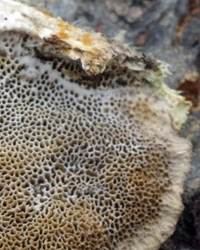 |
Tubes and Pores
The tubes are white and up to 6mm deep, terminating in mainly roundish pores (pictured left) often varying randomly in size and sometimes merging to produce a few angular/elongated pores; typically 3 to 4 pores per mm.
Initially white, the pore surface turns cream and later ochre or pale brown. |
| |
Spores
Cylindrical, smooth, 5.5-8.5 x 1.6-2.5µm; inamyloid.
Spore print
White. |
Odour/taste |
Fresh young brackets have a faint aniseed smell; the taste is bitter. |
Habitat & Ecological role |
This bracket fungus can be seen on many kinds of hardwoods but most commonly on dead Beech. It is a saprophytic fungus and causes white rot. |
Season |
These annual bracket fungi appear in late summer and autumn but the brackets may persist through the winter months in sheltered locations and are therefore recorded all year round. |
Similar species |
Trametes pubescens is an even paler bracket with a finely downy rather than coarsely hairy upper surface. |
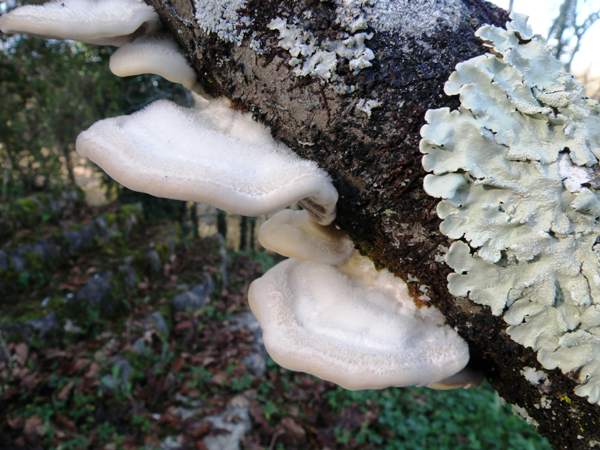
Culinary Notes
Although not generally reported as poisonous, these bracket fungi are too leathery to be considered edible.
Reference Sources
Fascinated by Fungi, 2nd Edition, Pat O'Reilly 2016, reprinted by Coch-y-bonddu Books in 2022.
BMS List of English Names for Fungi
Mattheck, C., and Weber, K. Manual of Wood Decays in Trees. Arboricultural Association 2003.
Dictionary of the Fungi; Paul M. Kirk, Paul F. Cannon, David W. Minter and J. A. Stalpers; CABI, 2008
Taxonomic history and synonym information on these pages is drawn from many sources but in particular from the British Mycological Society's GB Checklist of Fungi.
Top of page...
Fascinated by Fungi. Back by popular demand, Pat O'Reilly's best-selling 450-page hardback book is available now. The latest second edition was republished with a sparkling new cover design in September 2022 by Coch-y-Bonddu Books. Full details and copies are available from the publisher's online bookshop...